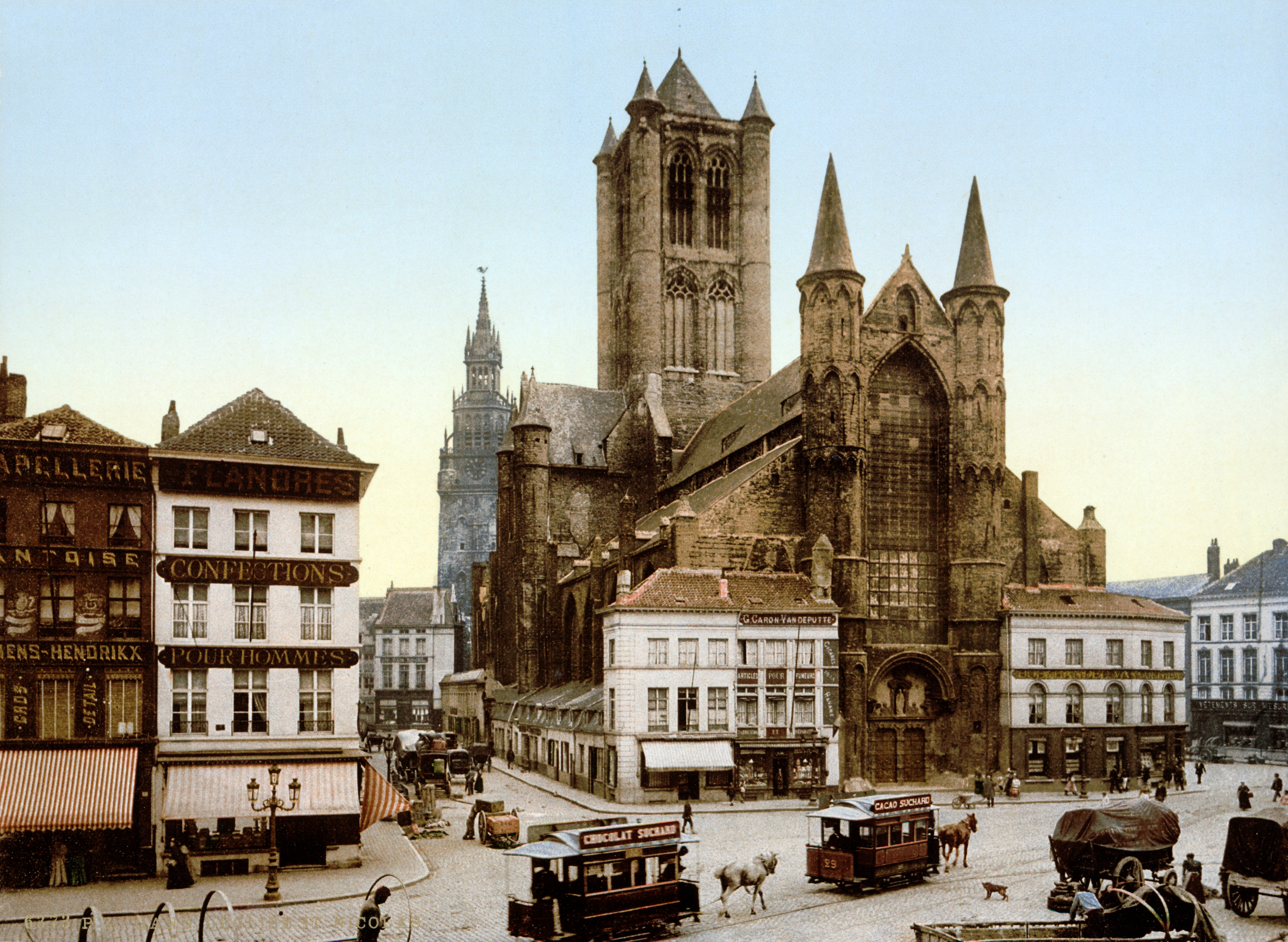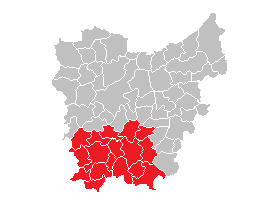|
Melden
Melden is a village belonging partly to the municipality of Oudenaarde and partly to the municipality of Kluisbergen. It is located in the Flemish Ardennes, the hilly southern part of the province of East Flanders, Belgium. History The village is located on an elevation near the Scheldt River. During canalisation efforts, remains on a Roman site were discovered. The village was conquered by the Count of Flanders in 1030. The economy was mainly based on animal husbandry and wool production. In 1960, the N8 was widened which resulted in the demolition of many house along the road. Melden was an independent municipality until 1971 when it was merged into Oudenaarde. Koppenberg The Koppenberg is a hill near Melden which is known for cycling races in general and the Tour of Flanders in particular. The road to the top of the hill is a steep, narrow cobblestone street which is serious challenge often forcing professionals to dismount. Notable people * Jan Verroken Jan Verroken (30 ... [...More Info...] [...Related Items...] OR: [Wikipedia] [Google] [Baidu] |
Tour Of Flanders
The Tour of Flanders ( nl, Ronde van Vlaanderen), also known as ''De Ronde'' (''"The Tour"''), is an annual road cycling race held in Belgium every spring. The most important cycling race in Flanders, it is part of the UCI World Tour and organized by Flanders Classics. Its nickname is ''Vlaanderens Mooiste'' (Dutch for "Flanders' Finest"). First held in 1913, the Tour of Flanders had its 100th edition in 2016. Today it is one of the five ''monuments'' of cycling, together with Milan–San Remo, Paris–Roubaix, Liège–Bastogne–Liège and the Giro di Lombardia. It is one of the two major Cobbled classics, anticipating Paris–Roubaix, which is on the calendar one week after the Tour of Flanders. The event had its only interruptions during World War I and has been organized without hiatus since 1919, the longest uninterrupted streak of any cycling classic. Six men hold the record of most victories, making the Tour of Flanders unique among the major classics. Belgians Achiel ... [...More Info...] [...Related Items...] OR: [Wikipedia] [Google] [Baidu] |
Jan Verroken
Jan Verroken (30 January 1917 – 24 July 2020) was a Belgian politician. Biography Born on 30 January 1917, Verroken served as burgomaster of Oudenaarde, President of the Christelijke Volkspartij in the Belgian Parliament, and a Deputy for the Oudenaarde constituency. He was also a member of the European Parliament and served on the Benelux Parliament. Verroken was detested in Wallonia, the francophone part of Belgium. During the Split of the Catholic University of Leuven Flemish students chanted "Walen buiten" (Walloons out), a slogan coined by Verroken. The university was split into the KU Leuven KU Leuven (or Katholieke Universiteit Leuven) is a Catholic research university in the city of Leuven, Belgium. It conducts teaching, research, and services in computer science, engineering, natural sciences, theology, humanities, medicine, ... and the Université catholique de Louvain. In a 2016 interview with Pierre Havaux, Verroken minimized his role in these events, a ... [...More Info...] [...Related Items...] OR: [Wikipedia] [Google] [Baidu] |
Flemish Ardennes
The Flemish Ardennes (Dutch: ''Vlaamse Ardennen'') is an informal name given to a hilly region in the south of the province of East Flanders, Belgium. Highest summit is the Hotondberg (145 m). Main characteristics of the region are rural hilly landscapes with hilltop bluebell woodlands (Muziekbos, Brakelbos, Kluisbos), windmills and watermills. The area is distinct and not adjacent to the larger Ardennes, which is further to the south east of the country in Wallonia, France, Germany and Luxembourg. Among the largest towns in the area are Oudenaarde, Ronse, Zottegem and Geraardsbergen. Cycling is particularly popular in the Flemish Ardennes. Many major bike races are held here, including a large part of the Tour of Flanders. Most of its toughest climbs (Koppenberg, Taaienberg, Molenberg, Paterberg, Oude Kwaremont, Muur van Geraardsbergen, Eikenberg) and most of its cobblestone-street sections (Paddestraat) are situated in the Flemish Ardennes. Photos Vlaamse Ardennen 03.jpg, ... [...More Info...] [...Related Items...] OR: [Wikipedia] [Google] [Baidu] |
Oudenaarde
Oudenaarde (; french: Audenarde ; in English sometimes ''Oudenarde'') is a Belgian municipality in the Flemish province of East Flanders. The municipality comprises the city of Oudenaarde proper and the towns of Bevere, Edelare, Eine, Ename, Heurne, Leupegem, Mater, Melden, Mullem, Nederename, Volkegem, Welden and a part of Ooike. From the 15th to the 18th century, but especially in the 16th century, Oudenaarde was a world-known centre of tapestry production. The town's name, meaning “old field”, still lingers on in “outnal”, an obsolete English term for a kind of brown linen thread. History The glory of Ename The history of the current municipality of Oudenaarde starts in 974, when Otto II, Holy Roman Emperor and king of Germany, built one of its three fortifications on the Scheldt at Ename to protect his kingdom against possible attacks from Francia (next to the other frontier post at Valenciennes, later on also the Antwerp). Ename grew very fast. By 1005, the ... [...More Info...] [...Related Items...] OR: [Wikipedia] [Google] [Baidu] |
Kluisbergen
Kluisbergen () is a municipality located in the Belgian province of East Flanders, along the Scheldt river. The municipality comprises the towns of , Kwaremont, and which fused in 1971. In 2021, Kluisbergen had a total population of 6,682. The total area is 30.38 km². The town of Ruien is the largest and has some outdoor facilities. Kluisbergen is also home to the "Kluisbos", a forest which has 2 ancient standing stones, dating back to Roman times. Geography Kluisbergen consists of four towns: Neighbouring towns/municipalities: Map Landscape The Scheldt makes up the northwestern border of Kluisbergen where the landscape is rather flat. Traveling south or southeast is met with an increasing moderately hilly landscape all the way to the southern border There are three main hills in Kluisbergen. The Kluisberg is mainly located on the border of Ruien and Orroir, stretching all the way to Kwaremont. The Paterberg is located in the middle of Kwaremont. The Hotondberg ... [...More Info...] [...Related Items...] OR: [Wikipedia] [Google] [Baidu] |
Cobblestone
Cobblestone is a natural building material based on cobble-sized stones, and is used for pavement roads, streets, and buildings. Setts, also called Belgian blocks, are often casually referred to as "cobbles", although a sett is distinct from a cobblestone by being quarried or shaped to a regular form, whereas cobblestone is generally of a naturally occurring form and is less uniform in size. Use in roading Cobblestones are typically either set in sand or similar material, or are bound together with mortar. Paving with cobblestones allows a road to be heavily used all year long. It prevents the build-up of ruts often found in dirt roads. It has the additional advantage of immediately draining water, and not getting muddy in wet weather or dusty in dry weather. Shod horses are also able to get better traction on stone cobbles, pitches or setts than tarmac or asphalt. The fact that carriage wheels, horse hooves and even modern automobiles make a lot of noise when rolling ove ... [...More Info...] [...Related Items...] OR: [Wikipedia] [Google] [Baidu] |
N8 Road (Belgium)
{{Belgium-road-stub ...
The N8 road in Belgium is a road connecting Brussels and Koksijde, passing Ninove, Oudenaarde, Kortrijk, Ypres and Veurne. The N8 is the old road from Brussels to the coast. Most sections have been replaced by motorways, and only serve a regional purpose, except for the which was supposed to go from Kortrijk to the coast, but which ends at Ypres. In 2012, the extension was permanently cancelled. See also * Transport in Belgium References 008 008, OO8, O08, or 0O8 may refer to: * The Streetwear Brand @008us , inspired by Ian Fleming & Virgil Abloh *"030", the fictional 030 Agent of MI6 * '' 038: Operation Exterminate'', a 1965 Italian action film * '' Explosivo 030'' a 1940 Argentine c ... [...More Info...] [...Related Items...] OR: [Wikipedia] [Google] [Baidu] |
Scheldt
The Scheldt (french: Escaut ; nl, Schelde ) is a river that flows through northern France, western Belgium, and the southwestern part of Netherlands, the Netherlands, with its mouth at the North Sea. Its name is derived from an adjective corresponding to Old English ' ("shallow"), English language, Modern English ''shoal'', Low German ''schol'', West Frisian language, West Frisian ''skol'', and Swedish language, Swedish (obsolete) ''skäll'' ("thin"). Course The headwaters of the Scheldt are in Gouy, Aisne, Gouy, in the Aisne department of northern France. It flows north through Cambrai and Valenciennes, and enters Belgium near Tournai. Ghent developed at the confluence of the Lys (river), Lys, one of its main tributaries, and the Scheldt, which then turns east. Near Antwerp, the largest city on its banks, the Scheldt flows west into the Netherlands toward the North Sea. Originally there were two branches from that point: the Oosterschelde (Eastern Scheldt); and the Westersc ... [...More Info...] [...Related Items...] OR: [Wikipedia] [Google] [Baidu] |
Countries Of The World
The following is a list providing an overview of sovereign states around the world with information on their status and recognition of their sovereignty. The 206 listed states can be divided into three categories based on membership within the United Nations System: 193 member states of the United Nations, UN member states, 2 United Nations General Assembly observers#Present non-member observers, UN General Assembly non-member observer states, and 11 other states. The ''sovereignty dispute'' column indicates states having undisputed sovereignty (188 states, of which there are 187 UN member states and 1 UN General Assembly non-member observer state), states having disputed sovereignty (16 states, of which there are 6 UN member states, 1 UN General Assembly non-member observer state, and 9 de facto states), and states having a political status of the Cook Islands and Niue, special political status (2 states, both in associated state, free association with New Zealand). Compi ... [...More Info...] [...Related Items...] OR: [Wikipedia] [Google] [Baidu] |
Belgium
Belgium, ; french: Belgique ; german: Belgien officially the Kingdom of Belgium, is a country in Northwestern Europe. The country is bordered by the Netherlands to the north, Germany to the east, Luxembourg to the southeast, France to the southwest, and the North Sea to the northwest. It covers an area of and has a population of more than 11.5 million, making it the 22nd most densely populated country in the world and the 6th most densely populated country in Europe, with a density of . Belgium is part of an area known as the Low Countries, historically a somewhat larger region than the Benelux group of states, as it also included parts of northern France. The capital and largest city is Brussels; other major cities are Antwerp, Ghent, Charleroi, Liège, Bruges, Namur, and Leuven. Belgium is a sovereign state and a federal constitutional monarchy with a parliamentary system. Its institutional organization is complex and is structured on both regional ... [...More Info...] [...Related Items...] OR: [Wikipedia] [Google] [Baidu] |
Communities And Regions Of Belgium
Belgium is a federal state comprising three communities and three regions that are based on four language areas. For each of these subdivision types, the subdivisions together make up the entire country; in other words, the types overlap. The language areas were established by the Second Gilson Act, which entered into force on 2 August 1963. The division into language areas was included in the Belgian Constitution in 1970. Through constitutional reforms in the 1970s and 1980s, regionalisation of the unitary state led to a three-tiered federation: federal, regional, and community governments were created, a compromise designed to minimize linguistic, cultural, social, and economic tensions. Schematic overview This is a schematic overview of the basic federal structure of Belgium as defined by Title I of the Belgian Constitution. Each of the entities either have their own parliament and government (for the federal state, the communities and the regions) or their own council an ... [...More Info...] [...Related Items...] OR: [Wikipedia] [Google] [Baidu] |






